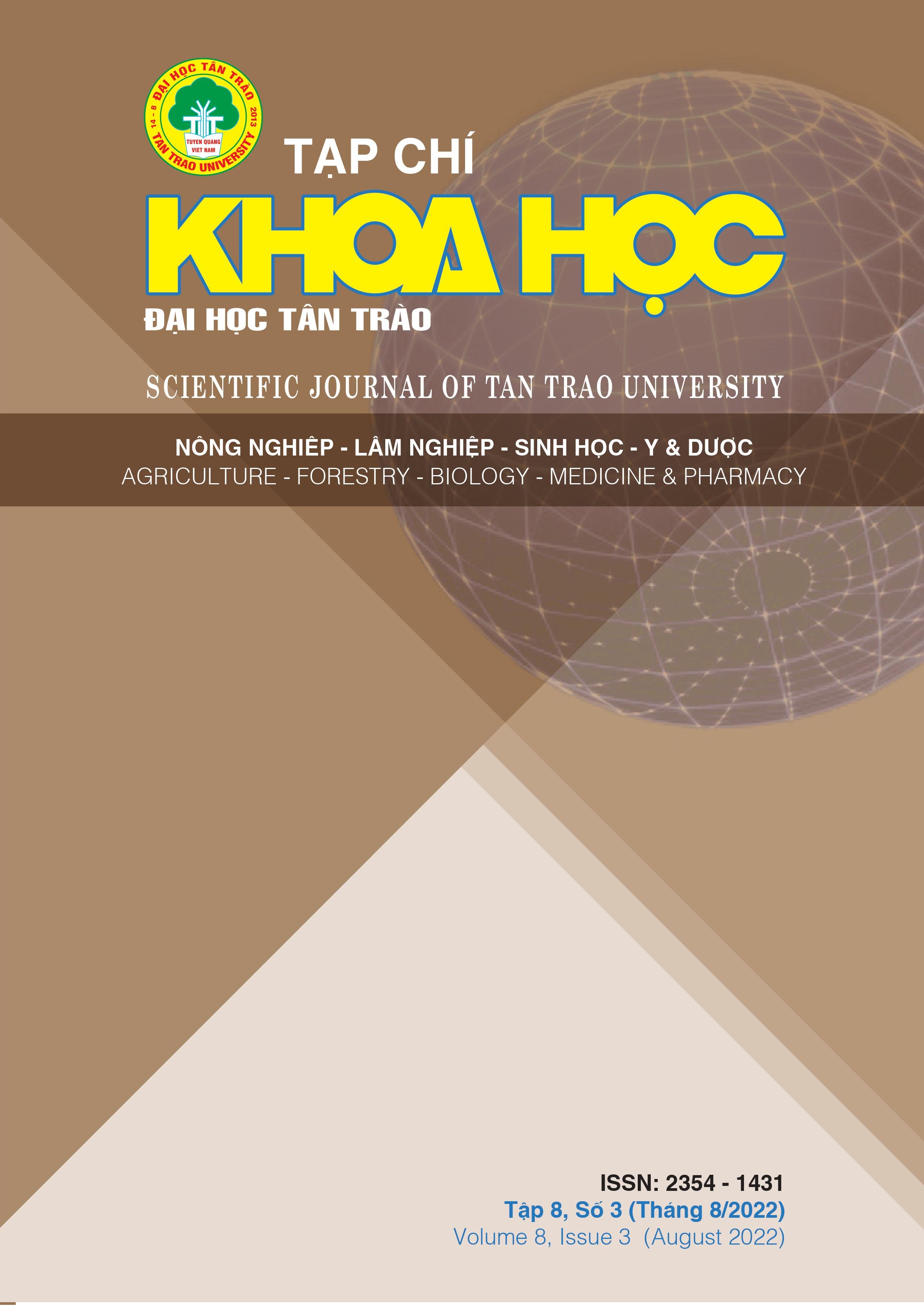NGHIÊN CỨU ẢNH HƯỞNG CỦA CHIỀU DÀI LÁT CẮT VÀ BIỆN PHÁP XỬ LÝ HOM CỦ ĐẾN CHẤT LƯỢNG CỦ GIỐNG ĐỊA HOÀNG ĐH02 TẠI PHÚ THỌ
DOI:
https://doi.org/10.51453/2354-1431/2022/808Từ khóa:
Lát cắt, Äịa hoà ng, hom củ, năng suất, mầm hữu hiệu, tá»· lệ sốngTóm tắt
Cây Địa hoàng là một dược liệu quý, được nhập nội từ Trung Quốc và trồng tại Việt Nam vào năm 1958. Chiều dài lát cắt và biện pháp xử lý hom củ của giống Địa hoàng có ảnh hưởng rõ rệt đến số mầm hữu hiệu, năng suất và chất lượng củ giống. Lát cắt hom giống dài từ 2,5 - 3 cm có năng suất đạt cao nhất và có tỷ lệ củ đạt tiêu chuẩn làm giống đạt cao nhất (70,1%) đối với giống Địa hoàng ĐH02. Xử lý bằng tro rơm rạ và xử lý bằng xi măng trắng có năng suất tương đương nhau và có sự sai khác rõ rệt với biện pháp xử lý khác lần lượt là 22,5 tấn/ha và 22,8 tấn/ha). Đây cũng là hai biện pháp xử lý có tỷ lệ củ đạt tiêu chuẩn làm giống cao nhất.
Tải xuống
Tài liệu tham khảo
[1]. Vo Van Chi (2012), Dictionary of Vietnamese medicinal plants, Medicine Publishing House, Hanoi
[2]. Nguyen Ba Hoat, Nguyen Duy Thuan (2005), Techniques of growing, using and processing medicinal plants, Agriculture Publishing House, 74-84.
[3]. Bajai YPS (1988), “Biotecnology in Agriculture and Forestry 4, Medicinal and Aromatic plants I”, Springer-Verlag Berlin Heidelberg: 501-511.
[4]. Park SU, Kim YK and Lee SY (2009), “Improved in-vitro plant regeneration and micropropagation of Rehmannia glutinosa L”, J. Medicinal Plants Res., 3(1): 31-34.
[5]. Zhang RX, Li MX and Jia ZP (2008), “Rehmannia glutinosa: review of botany, chemistry and pharmaco logy”, J. Ethnopharm., 117: 199-214.
Tải xuống
Đã Xuất bản
Cách trích dẫn
Số
Chuyên mục
Giấy phép

Tác phẩm này được cấp phép theo Giấy phép Quốc tế Creative Commons Attribution-ShareAlike 4.0 .
Bài báo được xuất bản ở Tạp chí Khoa học Đại học Tân Trào được cấp phép theo giấy phép Ghi công - Chia sẻ tương tự 4.0 Quốc tế (CC BY-SA). Theo đó, các tác giả khác có thể sao chép, chuyển đổi hay phân phối lại các bài báo này với mục đích hợp pháp trên mọi phương tiện, với điều kiện họ trích dẫn tác giả, Tạp chí Khoa học Đại học Tân Trào và đường link đến bản quyền; nêu rõ các thay đổi đã thực hiện và các nghiên cứu đăng lại được tiến hành theo cùng một bản quyền.
Bản quyền bài báo thuộc về các tác giả, không hạn chế số lượng. Tạp chí Khoa học Tân Trào được cấp giấy phép không độc quyền để xuất bản bài báo với tư cách nhà xuất bản nguồn, kèm theo quyền thương mại để in các bài báo cung cấp cho các thư viện và cá nhân.
Mặc dù các điều khoản của giấy phép CC BY-SA không dành cho các tác giả (với tư cách là người giữ bản quyền của bài báo, họ không bị hạn chế về quyền hạn), khi gửi bài tới Tạp chí Khoa học Đại học Tân Trào, tác giả cần đáp ứng quyền của độc giả, và cần cấp quyền cho bên thứ 3 sử dụng bài báo của họ trong phạm vi của giấy phép.






